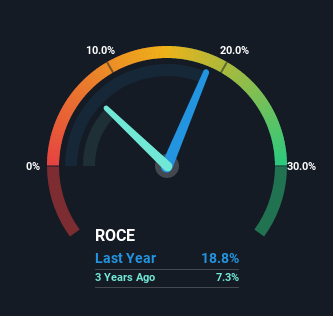Finding a business that has the potential to grow substantially is not easy, but it is possible if we look at a few key financial metrics. In a perfect world, we'd like to see a company investing more capital into its business and ideally the returns earned from that capital are also increasing. Ultimately, this demonstrates that it's a business that is reinvesting profits at increasing rates of return. Speaking of which, we noticed some great changes in Brim hf's (ICE:BRIM) returns on capital, so let's have a look.
Return On Capital Employed (ROCE): What Is It?
Just to clarify if you're unsure, ROCE is a metric for evaluating how much pre-tax income (in percentage terms) a company earns on the capital invested in its business. To calculate this metric for Brim hf, this is the formula:
Return on Capital Employed = Earnings Before Interest and Tax (EBIT) ÷ (Total Assets - Current Liabilities)
0.19 = €111m ÷ (€876m - €287m) (Based on the trailing twelve months to September 2022).
So, Brim hf has an ROCE of 19%. On its own, that's a standard return, however it's much better than the 8.7% generated by the Food industry.
See our latest analysis for Brim hf

While the past is not representative of the future, it can be helpful to know how a company has performed historically, which is why we have this chart above. If you're interested in investigating Brim hf's past further, check out this free graph of past earnings, revenue and cash flow.
The Trend Of ROCE
Investors would be pleased with what's happening at Brim hf. Over the last five years, returns on capital employed have risen substantially to 19%. The amount of capital employed has increased too, by 46%. So we're very much inspired by what we're seeing at Brim hf thanks to its ability to profitably reinvest capital.
For the record though, there was a noticeable increase in the company's current liabilities over the period, so we would attribute some of the ROCE growth to that. Effectively this means that suppliers or short-term creditors are now funding 33% of the business, which is more than it was five years ago. It's worth keeping an eye on this because as the percentage of current liabilities to total assets increases, some aspects of risk also increase.
In Conclusion...
To sum it up, Brim hf has proven it can reinvest in the business and generate higher returns on that capital employed, which is terrific. And a remarkable 196% total return over the last five years tells us that investors are expecting more good things to come in the future. In light of that, we think it's worth looking further into this stock because if Brim hf can keep these trends up, it could have a bright future ahead.
On a separate note, we've found 1 warning sign for Brim hf you'll probably want to know about.
While Brim hf may not currently earn the highest returns, we've compiled a list of companies that currently earn more than 25% return on equity. Check out this free list here.
Valuation is complex, but we're here to simplify it.
Discover if Brim hf might be undervalued or overvalued with our detailed analysis, featuring fair value estimates, potential risks, dividends, insider trades, and its financial condition.
Access Free AnalysisHave feedback on this article? Concerned about the content? Get in touch with us directly. Alternatively, email editorial-team (at) simplywallst.com.
This article by Simply Wall St is general in nature. We provide commentary based on historical data and analyst forecasts only using an unbiased methodology and our articles are not intended to be financial advice. It does not constitute a recommendation to buy or sell any stock, and does not take account of your objectives, or your financial situation. We aim to bring you long-term focused analysis driven by fundamental data. Note that our analysis may not factor in the latest price-sensitive company announcements or qualitative material. Simply Wall St has no position in any stocks mentioned.
About ICSE:BRIM
Brim hf
Engages in the fishing, processing, and marketing of ground fish and pelagic fish in Iceland.
Solid track record average dividend payer.
Market Insights
Community Narratives



